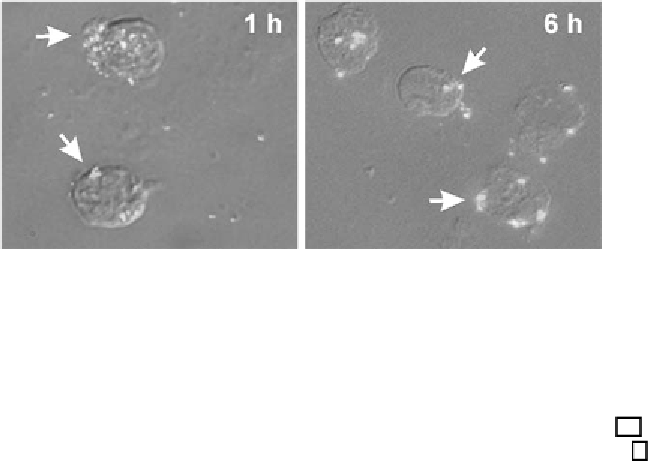Biology Reference
In-Depth Information
Fig. 2. Interaction of
Anaplasma phagocytophilum
with human neutrophils.
(A)
Ingestion of
A. phagocytophilum
by human neutrophils. Neutrophils were incubated
with
5-20
A. phagocytophilum/
neutrophil for the indicated times, and percent
ingestion (number of neutrophils containing internalized
A. phagocytophilum
) was
determined by fluorescence microscopy.
(B)
Micrographs illustrating ingestion of
A.
phagocytophilum
by human neutrophils. Green, intracellular bacteria. Red or red-
green (yellow), extracellular bacteria. Reprinted with permission from reference
(13)
.
Copyright 2005 The American Association of Immunologists, Inc. (
See
Color Plate 6,
following p. 46.)
∼
7. At desired time points, gently aspirate/remove supernatant and wash cells once
with 500 μL of cold PBS, aspirate wash. Add 300 μL of 4% paraformaldehyde
and fix cells on ice for 30 min.
8. To counterstain uningested
A. phagocytophilum,
aspirate fixative, wash once
with 500 μL of PBS, and add 500 μL of PBS containing 7.5 μg/mL anti-
AlexaFluor 488 (conjugated to AlexaFlour 594). Incubate for 15 min at room
temperature. Aspirate stain and wash twice in 500 μL of PBS.
9. Mount coverslips onto microscope slides. Drain off excess PBS by wicking the
edge on a paper towel and then dry the back with a tissue. Apply coverslip
facedown onto a slide with one drop of mounting media. Incubate in the dark
at 4 °C overnight to permit mounting media to fully harden.
10. Score phagocytosis on a fluorescence microscope. Count all bacteria associated
with 100 cells per time point per treatment from random fields of view. Bacteria
associated with neutrophils that are both red and green are uningested; bacteria
staining green only are ingested (
see
Note 14; Fig. 2A and B
and Color Plate 6,
following p. 46).
4. Notes
1.
Anaplasma phagocytophilum
has also been successfully propagated in a tick cell
line (ISE6 developed from
Ixodes scapularis
) grown at 34 °C
(15)
, microvascular
endothelial cell lines developed from human and rhesus origins
(16)
, and a
human immortalized megakaryocytic cell line
(17)
.




Search WWH ::

Custom Search